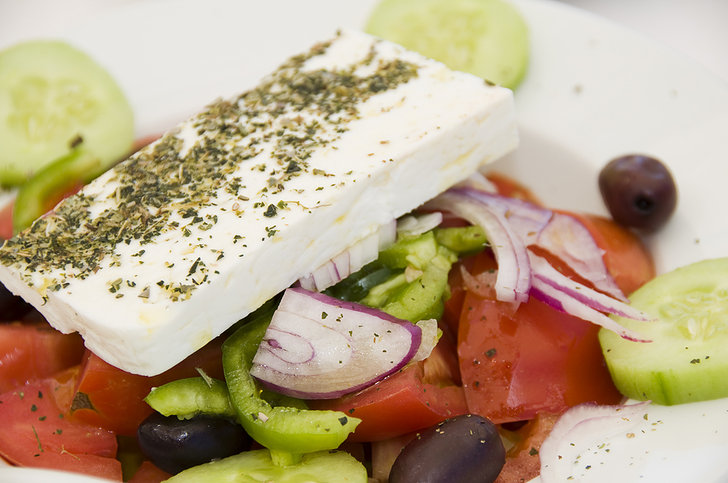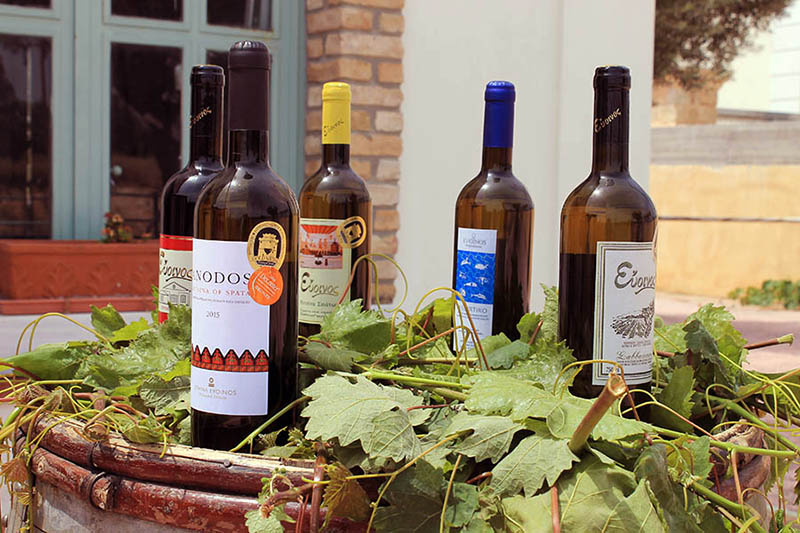FOOD & WINE
Essential to a Greek: fine fresh food & luscious local wine
Traditional Greek cuisine is the healthiest food in the Mediterranean. The food is not complicated. The diet is based largely on fruits, vegetables, fish, whole grains, cheese and yogurt. Protein sources come from beans and legumes such as fava, split peas, and lentils which are staples in soups, stews and salads. Eating is seasonal: in the summer tomatos are common while leeks and spinach prevail in the winter. Only in the past generation or so has meat skyrocketed in consumption. The traditional Greek meal, however, is humble and delicious.
Every region in Greece boasts their own local specialties. Here are just few to get your mouth watering:
- Serifos: unique fennel fritters — marathokeftedes
- Spetses: fish á la Spetsiota marinated in lime juice
- Corfu: bourdeto, a peppery fish stew of Venetian influence
- Napflio: gournopoula, a small pig roasted in the oven
- Crete: dakos, a barley rusk topped feta, oregano and olive oil
- Chios: mastelo cheese, made from the mastic resin, an anti-oxidant
- Olympia: a certain taverna in Olympia wins the prize for best moussaka
- Evia: a certain town, Kimi, produces the best figs for jams and sweets
- Stemnitsa: grilled lamb chops paidakia served in the village square
- Zakynthos: loukoumades, honeyed donuts
- Folegandros: matsata, rooster with thick macaroni

Greek Olive Oil – the secret of a successful dish
Greece is the largest olive oil producer in the world and unsurprisingly, olive oil rules its cuisine. A typical recipe can call for a cup or more of olive oil. Non-Greek cooks are tempted to fudge on this until they learn that substitutions or reductions in olive oil always diminish the flavor and authenticity of the dish. Enter the kitchen guilt-free — olive oil is rich in monounsaturated fat and studies suggest that increased olive oil consumption is associated with a decrease in coronary heart disease. Greeks practically bathe in it.
 What is a “Greek salad”?
What is a “Greek salad”?
“Greek salad” is a staple on many a menu, even found in ethnic eateries like Mexican or Italian restaurants. Yet, these Greek salads are imposters! A true Greek horiatiki, or village salad, doesn’t contain lettuce or crumbled feta cheese. The ingredients are simple and consistent: big chunks of juicy tomatoes, thick, crisp cucumbers, red onion and green pepper slices. Drench this mixture with olive oil and freshly squeezed lemon juice. Sprinkle in fresh oregano. Garnish with a few Greek olives. Add a generous slab of feta cheese. That’s it!
Feta and a Cornucopia of Cheeses
These days feta is as common to the American palate as Velveeta cheese was in the sixties. The difference is feta is healthy and tasty. Made from sheep and goat’s milk, Greeks let it age in large barrels for two months before consumption. Feta is practically the national food of Greece. In 2005, Europe’s highest court ruled that feta cheese is a traditional Greek product and non-Greek European feta producers are not allowed to call their product “feta.”
Greece’s best kept secret — its wines!
 The Greeks know a thing or two about wine since they’ve been producing wines for millennia. Wineries today are mostly family run, many for several generations. Greek wines are not so famous abroad because production in most wineries is not high enough for export: most Greek wine stays in Greece. Almost all Greek families own or have access to vineyards and produce their own wine for home consumption. The most popular commercial wine regions are Attica, Nemea, Macedonia, Peloponnese and Crete. Santorini wine deserves special mention. The grapes grow on circular vines that lie in the volcanic soil like wreathes. As the vines grow upward, they form a basket that collects the night fog, the source of water. See the Attica Wineries tour.
The Greeks know a thing or two about wine since they’ve been producing wines for millennia. Wineries today are mostly family run, many for several generations. Greek wines are not so famous abroad because production in most wineries is not high enough for export: most Greek wine stays in Greece. Almost all Greek families own or have access to vineyards and produce their own wine for home consumption. The most popular commercial wine regions are Attica, Nemea, Macedonia, Peloponnese and Crete. Santorini wine deserves special mention. The grapes grow on circular vines that lie in the volcanic soil like wreathes. As the vines grow upward, they form a basket that collects the night fog, the source of water. See the Attica Wineries tour.

Greek Tzatziki

Ingredients for 1 large bowl
- 1 kg strained yogurt
- 1 cup olive oil
- 2 tsp. Vinegar
- 1 large cucumber
- 4 cloves garlic
- 1 cup chopped dill
- 2 tbs chopped mint
- Pinch of salt
- For decorating
- 2 tsp olive oil
- some black olives
- Wash the cucumbers whole with the peel, cut the edges and grate from the thick side of a grater.
- Lightly season with salt and leave in a colander to strain fluids for about 15 minutes.
- Then press by hand to dry completely.
- Put the yogurt in a large bowl. Add the cucumber and mix well.
- Mash the garlic in a mortar with a little salt until creamy and put into the yogurt.
- Mix well, add the olive oil and vinegar.
- Season with salt lightly, add the dill and mint and stir.
Serve in bowls, drizzle with a little olive oil and decorate with black olives. Good to eat plain or as a dip.
Cheese pie – Tyropita
Ingredients for one medium oven tray

- 1 packet phyllo pastry
- For the filling
- 2 tbs fresh butter
- 3 tbs flour
- 1 water glass of warm milk
- 3 eggs
- 200g feta
- 1 cup grated cheese cheddar or similar
- 1 cup finely grated parmesan
- 1 pinch nutmeg
- Pepper
- oil for brushing the leaves
- In a large saucepan, add 2 tablespoons fresh butter heat well and add flour.
- Saute until brown and then empty the warm milk stirring continuously to make a paste.
- Remove the sauce from the heat crumble in the feta cheese and mix well.
- Add the grated cheese and finely the grated parmesan and pepper.
- Stir the mixture well. Put aside.
- Grease well a tray and lay 4 phyllo sheets in such a way as to cover the bottom and sides of pan, oiling one by one.
- Pour the filling on top and spread evenly with a fork.
- Turn the phyllo from the sides inwards over the filling and lay over another 4 phyllo sheets and again brush them with oil one by one.
- Bake the pie in the oven at 170 c until golden and crisp.
Let cheese pies cool, cut into portions, serve. Eat hearty!
Dolmadakia – vine leaves stuffed with rice.

- 250g vine leaves
- 1 bunch spring onions, finely chopped
- 2 onions, grated
- 250g short grain white rice
- 1/2 bunch parsley, finely chopped
- 1/2 bunch dill, finely chopped
- mint to taste, finely chopped
- 1cup extra virgin olive oil
- 1 1/4cup boiling water
- juice of 1 1/2 lemons
- salt, pepper
1.Wash and blanch the leaves in boiling water 2-3 minutes. Remove and refresh in cold water, let drain.
2. In a bowl, combine all the filling ingredients (spring onions, onions, parsley, dill, mint, rice, salt, pepper, 1/2 of the oil).
3. Spread out one leaf onto a plate, rough side up.
4. Place some filling on the stalk end of the leaf.
5. Fold over the stalk end of the leaf to cover the filling.
6. Tuck in each side of the leaf, and continue rolling gently until the filling is completely enclosed into a tight roll.
7. Cover the bottom of a casserole pot with left over leaves. Place the dolmades on the leaves, join side down, packed neatly side by side in rows.
8. Add the boiling water, the lemon juice, and the rest of the olive oil. Place an inverted plate over the dolmades, for some weight, place the lid on, and simmer gently till the rice is done.






